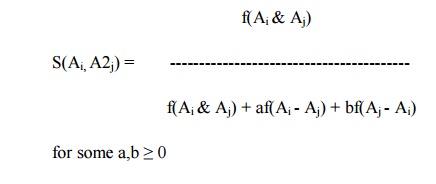Chapter: Artificial Intelligence
Measure for Matching
Measure for Matching
The problem of comparing structures without the use
of pattern matching variables. This requires consideration of measures used to
determine the likeness or similarity between two or more structures
The similarity between two structures is a measure
of the degree of association or likeness between the objectÔÇÖs attributes and
other characteristics parts.
If the describing variables are quantitative, a
distance metric is used to measure the proximity
Distance Metrics
├ś For all
elements x, y, z of the set E, the function d is metric if and only if d(x, x) = 0
d(x,y) Ôëą 0
d(x,y) = d(y,x)
d(x,y) ÔëĄ d(x,z) + d(z,y)
The Minkowski metric is a general distance measure
satisfying the above assumptions
It is given by

For the case p = 2, this metric is the familiar
Euclidian distance. Where p = 1, dp is the so-called absolute or
city block distance
Probabilistic measures
The representation variables should be treated as
random variables
Then one requires a measure of the distance between
the variates, their distributions, or between a variable and distribution
One such measure is the Mahalanobis distance which
gives a measure of the separation between two distributions
Given the random vectors X and Y let C be their
covariance matrix
Then the Mahalanobis distance is given by
= XÔÇÖC-1Y
Where the prime (ÔÇś) denotes transpose (row vector)
and C-1 is the inverse of C
The X and Y vectors may be adjusted for zero means
bt first substracting the vector means ux and uy
Another popular probability measure is the product
moment correlation r, given by

Where Cov and Var denote covariance and variance
respectively
The correlation r, which ranges between -1 and +1,
is a measure of similarity frequently used in vision applications
Other probabilistic measures used in AI
applications are based on the scatter of attribute values
These measures are related to the degree of
clustering among the objects
Conditional probabilities are sometimes used
For example, they may be used to measure the likelihood that a given X is a member of class Ci , P(Ci| X), the conditional probability of Ci given an observed X
These measures can establish the proximity of two
or more objects Qualitative measures
Measures between binary variables are best described using contingency tables in the below Table

The table entries there give the number of objects
having attribute X or Y with corresponding value of 1 or 0
For example, if the objects are animals might be
horned and Y might be long tailed. In this case, the entry a is the number of
animals having both horns and long tails
Note that n = a + b + c + d, the total number of
objects
Various measures of association for such binary
variables have been defined
For example

Contingency tables are useful for describing other
qualitative variables, both ordinal and nominal. Since the methods are similar
to those for binary variables
Whatever the variable types used in a measure, they
should all be properly scaled to prevent variables having large values from
negating the effects of smaller valued variables
This could happen when one variable is scaled in
millimeters and another variable in meters
Similarity measures
Measures of dissimilarity like distance, should
decrease as objects become more alike
The similarities are not in general symmetric
Any similarity measure between a subject
description A and its referent B, denoted by s(A,B), is not necessarily equal
In general, s(A,B) Ôëá s(B,A) or ÔÇťA is like BÔÇŁ may
not be the same as ÔÇťB is like AÔÇŁ
Tests on subjects have shown that in similarity
comparisons, the focus of attention is on the subject and, therefore, subject
features are given higher weights than the referent
For example, in tests comparing countries,
statements like ÔÇťNorth Korea is similar to Red ChinaÔÇŁ and ÔÇťRed China is similar
to North KoreaÔÇŁ were not rated as symmetrical or equal
Similarities may depend strongly on the context in
which the comparisons are made
An interesting family of similarity measures which
takes into account such factors as asymmetry and has some intuitive appeal has
recently been proposed
Let O ={o1, o2, . . . } be
the universe of objects of interest
Let Ai be the set of attributes used to
represent oi
A similarity measure s which is a function of three
disjoint sets of attributes common to any two objects Ai and Aj
is given as
s(Ai, Aj) = F(Ai
& Aj, Ai - Aj, Aj - Ai)
Where Ai & Aj is the set
of features common to both oi and oj
Where Ai - Aj is the set of
features belonging to oi and not oj
Where Aj - Ai is the set of
features belonging to oj and not oi
The function F is a real valued nonnegative
function
s(Ai, Aj) = af(Ai
& Aj) ÔÇô bf(Ai - Aj) ÔÇô cf(Aj - Ai)
for some a,b,c Ôëą 0
Where f is an additive interval metric function
The function f(A) may be chosen as any nonnegative
function of the set A, like the number of attributes in A or the average
distance between points in A

When the representations are graph structures, a similarity
measure based on the cost of transforming one graph into the other may be used
For example, a procedure to find a measure of
similarity between two labeled graphs decomposes the graphs into basic
subgraphs and computes the minimum
cost to transform either graph into the other one,
subpart-by-subpart
Related Topics